STRANGER THINGS//Il palazzo più pesante del mondo [ita-eng]
Tutti sappiamo qual è il grattacielo più alto o la piazza più grande del mondo , ma non comunemente ci si fa la domanda: qual è il palazzo più pesante del mondo?
Everybody knows which is the highest skyscraper or the largest square in the world, but commonly we never ask:which is the heaviest building in the world?

Palatului Parlamentului.
La risposta l’ho trovata a Bucarest, dove ho passato una giornata lo scorso weekend. Non ci si aspetterebbe di incontrare un’opera mastodontica come questa in una delle capitali europee più piccole e “sfortunate”: storicamente la Romania è stata territorio di conquista da parte degli imperi in espansione o degli stati limitrofi, tant’è che ha acquisito l’indipendenza dall’impero ottomano soltanto nel 1878. I segni delle numerose influenze culturali, nonostante i bombardamenti e i terremoti, sono ancora visibili “sparsi” in giro per la città: mentre si cammina nel centro visibilmente ricostruito, ci si imbatte ogni tanto in chiesette ortodosse in muratura piene di oro e affreschi, costrette nei propri piccoli lotti e circondati da condomini di bassa qualità.
I found the answer in Bucharest, where I passed a day out during the last weekend. You wouldn’t expect to come across such a gigantic work in one of the most “unlucky” and small european capitals: Romania has historically been conquest territory to expanding empires or to neighbouring states, indeed it gained independence from ottoman empire only in 1878. The signs of the various cultural influences, although bombing and earthquakes, are still visible “scattered” in the city: while you walk in the visibly rebuilt city center, once in a while you run into orthodox churches, full of golden and frescos, closed in their small blocks and surrounded by low quality apartment buildings.
Una foto rubata ad un battesimo ortodosso.
L’evento che più ha trasformato la Romania e, morfologicamente, la città di Bucarest, è stato il regime di Nicolae Ceaușescu, che instaurò una repressiva dittatura comunista smantellata soltanto nel 1989 con il suo assassinio. Non mi soffermerò sui provvedimenti dannosi che egli mise in atto dal punto di vista politico ed economico, ma è necessario introdurre il personaggio per comprendere il significato della costruzione del Palazzo: il dittatore era una figura megalomane (si appellò modestamente “Genio dei Carpazi”) e voleva rendere Bucarest, già definita “piccola Parigi” per la sua effigie ottocentesca, una città degna dei suoi progetti per la potenza rumena. In particolare dopo il terremoto del 1977, Ceausescu iniziò un programma di ricostruzione chiamato Progetto Bucarest, in modo da replicare la città di Pyongyang, in Nord Corea. Necessario era un edificio che facesse da simbolo a questo programma.
The event which transformed most Romania and, morphologically, the city of Bucharest, was Nicolae Ceausescu regime, who established a repressive communist dictatorship, dismantled only in 1989 with its murder. I won’t analyze the harmful political and economical provisions he made, but it’s necessary to introduce the character to understand better the significance of the building: the dictator was megalomaniac (he modestly called himself “Genius of Carpathians”) and he wanted to make Bucharest, already defined “little Paris” for its 19th century looking, a proper city for its projects for romanian power. In particular after 1977 earthquake, Ceausescu began a reconstruction program called Project Bucharest, in order to replicate the city of Pyongyang, in North Korea. A building which could be the symbol for this program was necessary.
In questo contesto nasce l’idea del Palazzo del Parlamento: 350.000 mq, otto piani fuori terra più quattro seminterrati, interamente realizzato con materiali di origine rumena come marmi, cristalli e legni pregiati, che lo rendono il palazzo più pesante del mondo e quello più grande dopo il Pentagono.Per fare un pò di calcoli all’interno del palazzo ci sono:
3500 tonnellate di cristallo usate per 480 lampadari
1409 tra applique e specchi da parete
700mila tonnellate di acciaio e bronzo per porte e finestre monumentali
1 milione di metri cubi di marmo (paragonabile a un’intera montagna)
900mila metri cubi di legno
200mila metri quadri di tappeti di varie dimensioni, assemblati direttamente all’interno del palazzo poiché troppo grandi per essere inseriti all’interno.
In this context was born the idea of the Palatului Parlamentului (Parliament Palace): 350.000 sqm, 8 floors plus 4 underground, completely realized with romanian original materials such as marbles, crystals and fine wood essences,which make it the heaviest building of the world and the second largest building after Pentagon. Just to do some math in the palace there are:
3500 tons of crystal used for 480 chandeliers
1409 applique and ceiling mirrors
700.000 tons of steel and bronze for monumental doors and windows
1 million cubic meters of marble (comparable to a full mountain)
900.000 cubic meters of wood
200.000 sqm of carpets, various dimensions,assembled directly in the palace because it were too large to be whole transported in the building.

Vista dall'ingresso del palazzo.
Per la sua realizzazione furono demoliti monasteri, archivi storici, un ospedale, botteghe antiche e fabbriche, rimuovendo dalla propria abitazione circa 40mila persone; a lavorare alla realizzazione del palazzo furono tra i 20 e i 100 mila, di cui in gran parte morti per le condizioni di lavoro disumane.
For its realization monasteries, historical archives, hospitals, old workshops and factories were demolished, removing from their residence almost 40.000 people; between 20.000 and 100.000 worked to build the palace, whom many died for inhuman working conditions.
La prima vista si ha arrivando dalla vasta e moderna Piazza Unirii, percorrendo un viale alberato dal quale si percepisce il terrapieno contenente i primi 4 piani. L’ingresso non si trova in asse, ma lateralmente al palazzo, ciò significa ad almeno 300 metri di cammino dall’arrivo del boulevard!
The first sight of the palace is arriving from the wide and modern Unirii square, walking in a tree-lined boulevard; from here you can see the embankment which contains the first 4 floors. The entrance is not on the principal axis, but on the lateral part, so you have to walk approximately other 300 metres from the front of the palace to his side!
Già dall’ingresso si percepisce quanto anacronistico e insensato possa risultare quell’abnorme palazzo: la biglietteria, costituita da un bancone in legno probabilmente comprato all’Ikea, e lo shop del museo, delimitato da soli pannelli in plexiglass, stonano con la grandezza degli spazi in cui sono collocati, cozzano con i marmi di qualità e gli immensi giardini di rose su cui affacciano, rendendo il tutto un pò “pacchiano”.
From the entrance you already can feel how anachronistic and nonsense can be that abnormal palace: the ticket desk, made of a wooden counter probably bought at Ikea, and the museum shop, defined just by plexiglass panels, clash with the width of the spaces where they are placed, discord from the high quality marbles and the wide rose gardens close to it, making the whole thing a little “tacky”.
Con il proseguire della visita guidata è un susseguirsi di “ohh” sbalorditi: l’interno del palazzo è qualcosa di folle. Ogni stanza è concepita in uno stile diverso e arredata nei minimi dettagli, in modo da poter ostentare un potere in realtà inconsistente: il costo dell’opera probabilmente avrebbe potuto coprire quasi interamente il debito pubblico rumeno. Il tutto in uno stile arcaico per l’epoca, una fusione di neoclassicismo, barocco, modernismo, che risulta anacronistico se si pensa che negli stessi anni si realizzava l’Institut du monde arabe o si elaborava il progetto del Guggenheim di Bilbao.
Going on with the visit it’s a sequence of astonished “ohh”: the interior of this palace is crazy. Every room is conceived in a different style and furnished in every detail, in order to flaunt a power in reality inconsistent: the costs of this building would have probably remedy almost entirely the romanian public debit. The whole thing is realized in a style archaic for its era, a fusion of neoclassicism, baroque, modernism, which looks anachronistic if you think that in the same years was built the Institut du monde arabe, and was developed the first project for the Guggenheim in Bilbao.
La prima stanza in cui si entra è la sala del teatro, con uno stile che “scimmiotta” l’art nouveau, ricco di poltrone in pelle e legno intarsiato, vetri colorati, dettagli in oro; ma l’oggetto che attira di più l’attenzione di tutti è un gigantesco lampadario in cristallo, sotto il quale “nessuno vuole mai prendere posto durante gli spettacoli nel timore che gli caschi addosso” (cito la guida).
The first room you can enter is the theater room, with a “fake” art nouveau style, very rich and furnished with leather and wood marquetry, coloured glasses, golden details; but the object catching the attention is a gigantic crystal chandelier, under which “nobody wants to seat for a show, afraid of it falling” (just quoting the guide).
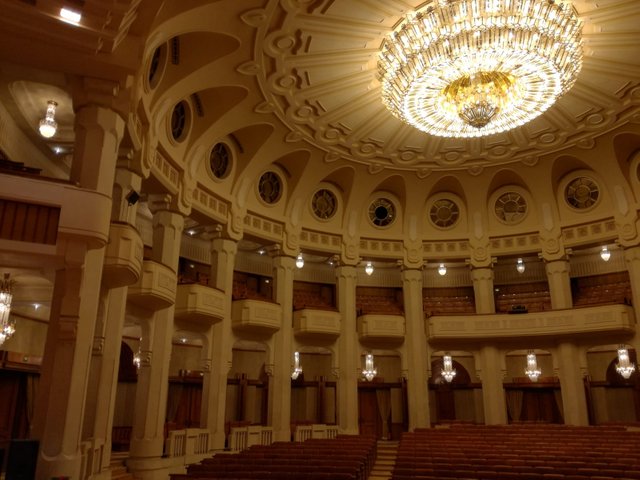
La sala Teatro.
E da qui, tutta una sfilza di sale, tutte enormi ed ognuna con una caratteristica diversa: la sala rosa, con tutti i rivestimenti in broccato rosa, per i ricevimenti di lusso; la sala per gli incontri internazionali, con un particolare marmo proveniente dalla transilvania; la sala auditorium, con una volta a botte vetrata di 28 metri di larghezza; la sala conferenze, tutta in legno di quercia; la sala dei Diritti Umani (intitolata precedentemente al dittatore), con una tavola rotonda per ospitare tutti i capi di stato, che nasconde nelle pareti passaggi segreti per eventuali rivolte. Il tour termina con la sala più sconvolgente di tutte: la sala Unirii, 53 metri x 42, colonne simil-corinzie e un meraviglioso soffitto traslucido, con due cornici sui lati corti della sala, attualmente vuote poiché nate per ospitare i ritratti alti 13 metri del dittatore con la sua coniuge.
From here, a serie of rooms, all enormous and every of them with a different feature: the pink room, where every coating is in pink brocade, for luxury receptions; the international meetings room, with a particular marble coming from Transylvania; the auditorium room, with a 28 m wide glass barrel vault; conference hall, completely made of oak wood; Human Rights hall (before named after the dictator), with a round table which should have hosted all the heads of state, and hides in its walls some secret paths to protect from rebellions. The tour ends with the most astonishing room: the Unirii hall, 53 meters x 42, corynthian-like columns and a marvellous traslucent ceiling, with two frames on the short sides of the room, now empty because they were born to host two portraits, 13 meters high, of the dictator with his wife.
Uno dei tanti disimpegni del palazzo, con scale monumentali e tende infinitamente grandi: per lavarle sono state progettate lavatrici apposite.
Ceausescu non ha assistito al completamento del palazzo, avvenuto nel 1990. Attualmente soltanto 40 di 1100 stanze vengono utilizzate, in parte per ospitare la sede la camera dei deputati, il resto per essere affittate per eventi privati.
Ceausescu didn’t see the completion of this palace, happened in 1990. Today just 40 of 1100 rooms are used, partly to host the Chamber of Deputies, partly to be rent for private events.
La Sala Unirii con la grande cornice destinata al ritratto di Ceausescu, in allestimento per un evento privato.
Il controsenso di questo edificio mastodontico si apprezza affacciandosi al balcone della sala auditorium: un’imponente struttura che però affaccia su architettura comunista di scarsa qualità, su un viale lunghissimo che sembra non avere un terminale. Concepito come simbolo di grandezza e fasto, il Palazzo del Popolo (viene chiamato anche così) è finito per diventare un oggetto isolato simbolo di disprezzo e ostentazione, che però mantiene il fascino di un’opera simbolo del suo tempo, nel bene e nel male.
The contradiction of this mastodonic building can be evaluated lookin out the balcony of the auditorium: a gigantic structure which faces some low quality communist architecture, on a long boulevard which looks not having a end. Conceived as a greatness and splendor symbol, the People Palace (as it’s also called) turned out to become an isolated object symbol of scorn and flaunt, which preserves the charm of a work symbol of its time, for better or worse.
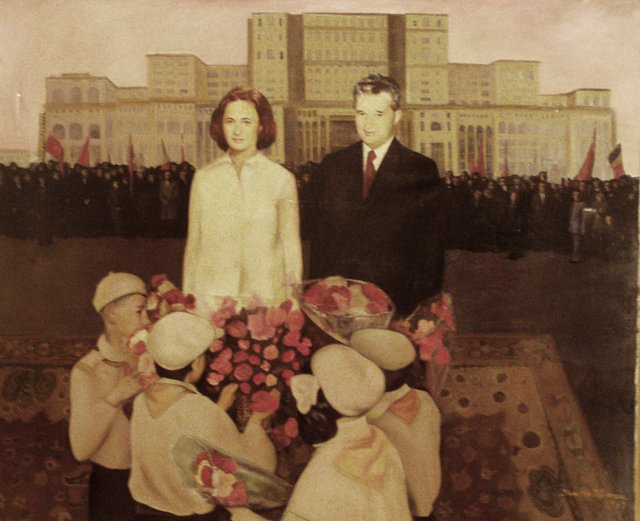
Nicolae e Elena Ceausescu dinanzi al Palazzo del Parlamento. Foto di un quadro esposto a Bucharest.
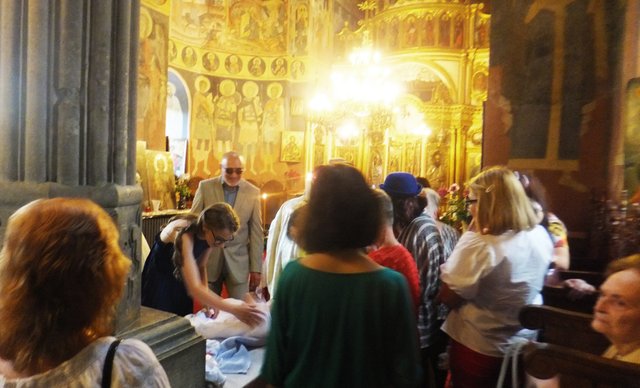
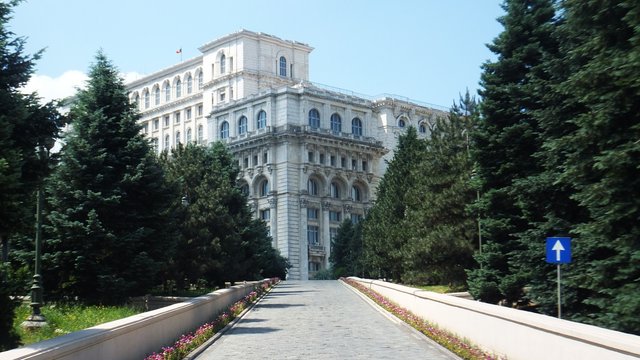
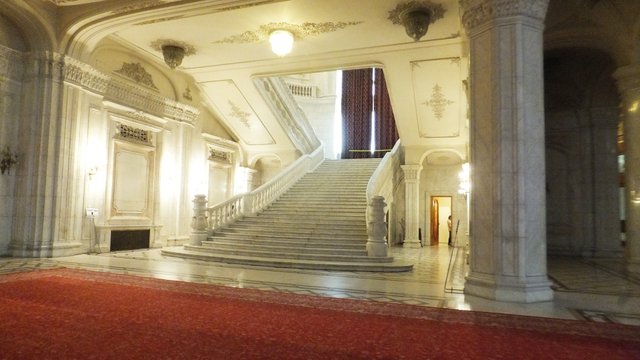
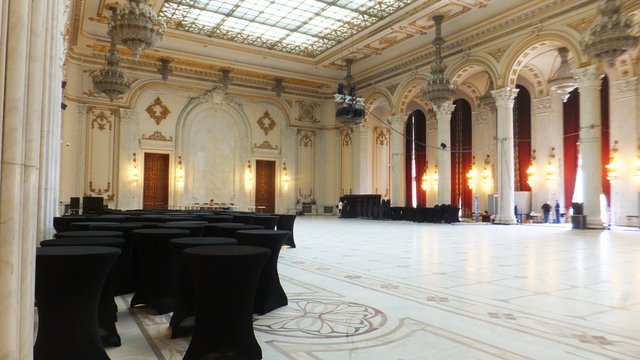
Brava, come sempre! Non conosco la Romania e non sapevo che ospitasse un palazzo di tali proporzioni, è gigantesco! Onestamente sono colpita (ma non stupita, ammetto) dalle contraddizioni del caso, se penso a quel lampadario mi vengono i brividi. Di base, l'edifico mi sembra che sia più fumo che arrosto, quasi fosse lì solo per un'esigenza di pura ostentazione ma senza una consistenza reale o uno stile unico. Mi chiedo perché? quando vedo certe cose. La sua costruzione ha causato un cambio radicale del contesto in cui è inserito (hanno rinunciato a un ospedale!), ma alla fine dei conti non è stata utilissima, visto che ne viene usata soltanto una piccola parte...beh, le contraddizioni non le abbiamo soltanto noi in Italia! XD
Complimenti :)
Frutto delle solite manovre politiche estremamente dannose... e devo dire che questo esempio è davvero eclatante!
Interessantissimo articolo :D
veramente ben fatto e molto interessante!
Grazie! :D
Mi associo a chi ti ha già fatto i complimenti marielladeg.
Ciao, grazie per il post 👍
Grazie a te per la lettura!
Anche io ji aggrego , complimenti per l'articolo.
The sheer size of this landmark building makes it hard to maintain and definitely will become a burden for the community since there’s no royals residing there and to maintain anymore. However, it is truly a remarkable piece of architecture that could be reuse adaptivel in the modern context. Amazing facts I learned today :)
Reuse was the first thing I thought about... but unfortunately it's now half closed to public :(
I see, sometimes it may due to preservation purpose which it cannot cater to too much crowd. Nonetheless, as long as it is still standing, there are opportunities for us to utilize it differently.
Congratulations @marielladeg! You have completed the following achievement on Steemit and have been rewarded with new badge(s) :
Click on the badge to view your Board of Honor.
If you no longer want to receive notifications, reply to this comment with the word
STOPCongratulations @marielladeg! You have completed the following achievement on the Steem blockchain and have been rewarded with new badge(s) :
Click on the badge to view your Board of Honor.
If you no longer want to receive notifications, reply to this comment with the word
STOPDo not miss the last post from @steemitboard:
Congratulations @marielladeg! You have completed the following achievement on the Steem blockchain and have been rewarded with new badge(s) :
Click here to view your Board of Honor
If you no longer want to receive notifications, reply to this comment with the word
STOPCongratulations @marielladeg! You received a personal award!
Click here to view your Board
Do not miss the last post from @steemitboard: